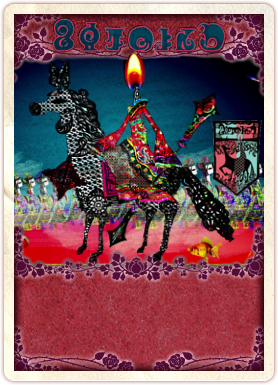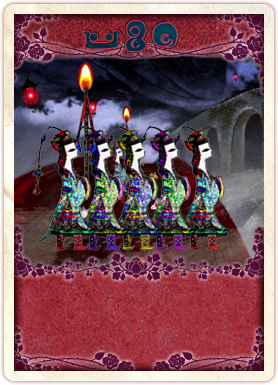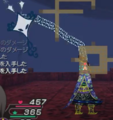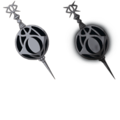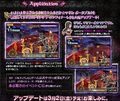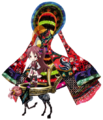Ophelia: Difference between revisions
No edit summary |
m (→Gallery) |
||
| (39 intermediate revisions by 14 users not shown) | |||
| Line 1: | Line 1: | ||
'''Ophelia''' ({{Runes|OPHELIA}}) is the [[witch]] form of [[Kyoko Sakura]], making an appearance in ''[[Madoka Magica Portable]]''. Like the anime witches, she was designed by [[Gekidan Inu Curry]]. She also appears in Mami's Heart Pounding Tiro Finale. | |||
'''Ophelia''' ({{Runes|OPHELIA}}) is the [[witch]] form of [[Kyoko Sakura]], making an appearance in ''[[ | |||
==Witch Card== | |||
{{Card | {{Card | ||
|name = Ophelia | |name = Ophelia | ||
|runes = OPHELIA | |runes = OPHELIA | ||
|image = File: | |image = File:Ophelia_Card_v2.png | ||
|japanese_desc = 武旦の魔女。その性質は自棄。霧の中を虚ろな足どりで永遠にさまよい続ける魔女。いつも傍らにいる馬が何だったのか魔女にはもう思い出せない。 | |japanese_desc = 武旦の魔女。その性質は自棄。霧の中を虚ろな足どりで永遠にさまよい続ける魔女。いつも傍らにいる馬が何だったのか魔女にはもう思い出せない。 | ||
|english_desc = | |english_desc = | ||
The witch of wǔdàn. Her nature is abandonment | The witch of wǔdàn. Her nature is abandonment. A witch who eternally wanders with hollow footsteps within the fog. She can no longer remember what the horse that always accompanies her was. | ||
|type = Wǔdàn witch | |type = Wǔdàn witch | ||
|nature = Abandonment | |nature = Abandonment | ||
|episodes = [[Puella Magi Madoka Magica Portable]] | |episodes = [[Puella Magi Madoka Magica Portable]], Madogatari Event | ||
}} | }} | ||
== Minions == | == Minions == | ||
{{Card | {{Card | ||
|name = | |name = Zoe | ||
|runes = | |runes = ZOE | ||
|image = | |image = File:Ophelia_Minions_Card.png | ||
|japanese_desc = 武旦の魔女の手下。その役割は行進。霧の中を規則正しく歩き続ける。主である魔女がこの使い魔の側に寄る事はない。 | |japanese_desc = 武旦の魔女の手下。その役割は行進。霧の中を規則正しく歩き続ける。主である魔女がこの使い魔の側に寄る事はない。 | ||
|english_desc = The wǔdàn witch's minions, whose task is to march. They continually walk through the fog in an orderly fashion. The witch typically doesn't have any reason to approach these familiars. | |english_desc = The wǔdàn witch's minions, whose task is to march. They continually walk through the fog in an orderly fashion. The witch typically doesn't have any reason to approach these familiars. | ||
|type = Wǔdàn witch's minion | |type = Wǔdàn witch's minion | ||
|task = Marching | |task = Marching | ||
|episodes = [[Madoka Magica Portable]] | |episodes = [[Madoka Magica Portable]], Madogatari Event | ||
}} | }} | ||
== | ==History== | ||
[[ | ===Madoka Magica Portable=== | ||
Ophelia and her familiars make their debut in [[Madoka Magica Portable]]. Ophelia appears in [[Madoka_Magica_Portable_Kyoko_Route|Kyoko's Route]] if met with the right conditions. She also appears as a boss in the Oblivious barrier on floor 30. Her familiars can appear in any Mysterious Witch's barrier. | |||
Kyoko and [[Madoka]] try to save [[Sayaka]] who's transformed into [[Oktavia]] but find that [[Homura]] has already killed her. Kyoko is furious at her and if her Soul Gem is dark enough, Homura's words make Kyoko realise how meaningless her life is now. She laughs and says she can't save anyone she loves and will instead curse the world. Kyoko turns into Ophelia but is killed by Homura. | |||
===[[Magia Record]]=== | |||
====In-Game ([[Kyoko Sakura in Magia Record|Normal]] version) description==== | |||
The Doppel of abandonment. Its form is a Wǔdàn. The master of this emotion doesn’t trust its mysterious power, she only borrows its weapon and wields it herself. To the master, it's no more than a hateful thing that drags up her painful past due to its power, a dubious hypnotic magic that controls mist to produce illusions. But even still, it possesses her regrets, hidden deep in her heart, so she allows it to aid her somewhat in battle, though she remains suspicious of it. | |||
The Doppel itself is the fluttering kimono-like thing, while the candlestick holder the master rides is a separate being altogether. | |||
''(This is the second version of the Doppel description. The Japanese text of the first version can be found the gallery.)'' | |||
====[[Kyoko_Sakura_(Swimsuit_ver.)|Swimsuit]] version description==== | |||
The master of this emotion does not trust its mysterious power, but she cannot hide her excitement over finally being able to swim. Although its master typically despises Doppels, this Doppel uses hypnotic magic to give her the illusion that she can swim. Her excitement is apparent in its attack as well. When sunlight hits the mirror on its back, it concentrates all that energy into a beam that it rains down on its enemies. As soon as it has dealt with them, its master rides the candlestick holder sea turtle, and swims freely with the fish of the sea. | |||
== | ==Observations== | ||
*Ophelia can be thought of as a [[wikipedia:Headless_Horseman|headless horseman]] | *Ophelia can be thought of as a [[wikipedia:Headless_Horseman|headless horseman]] | ||
** | ** Technically, the witch seems to have an eye below the flame, making Ophelia more of a candle-headed horseman. The impression of being headless is likely intentional, as the witch's "head" is flat enough to resemble a neck | ||
** | **In Kyouko's puppet show in episode 7, candles are strongly associated with her father. They appear next to him several times, most notably during a sermon. When she describes how he killed the rest of her family and hung himself, his puppet falls with its head consumed by flame and ignites the rest of the puppets | ||
***In | *Ophelia's familiars are colorfully attired warriors, most of whom march around aimlessly. One has a dragon's head emerge from its neck for a powerful melee attack. Another has the ability to summon melee familiars by ringing a bell, and a long-range fire attack. The two reflect the hybrid abilities of Kyoko who possesses both strong melee abilities and range abilities with her weapon | ||
*** | *The ringing of [[:wikipedia:Bell (instrument)|bells]] have their place in religious ceremonies, rituals and traditions. In the Eastern world, the traditional forms of bells are temple and palace bells, small ones being rung by a sharp rap with a stick, and very large ones rung by a blow from the outside by a large swinging beam. The bell used by the familiar is a [[:wikipedia:Suzu|Suzu bell]], that is traditionally used to summon [[:wikipedia:Kami|kami]]. | ||
*There are various colored fish swimming in her barrier. They are part of the scenery and not actually familiars. Fish have various symbolic meanings: | |||
**Early Christians used a [[wikipedia:Ichthys|fish symbol]] to represent the Christian faith. | |||
**In Buddhism, fish can represent abundance and fertility, or living beings who practice the dharma need have no fear to drown in the ocean of suffering, and can freely migrate (chose their rebirth) like fish in the water. | |||
**Adaptability, change, and transformation in Greco-Roman, East Indian, and Norse mythology. | |||
**Goldfish are associated with fortune and wealth. One of the [[wikipedia:Ashtamangala|eight auspicious signs]] of Buddhism is a pair of goldfish, representing the state of fearless suspension in a harmless ocean of [[wikipedia:Samsara|samsara]]. | |||
*It is suggested that [[:File:Blu_ray_mermaid_unicorn_ep_9.jpg|the symbolism of the unicorn]] represents innocence. The fact that Ophelia is riding a horse, instead of a unicorn, has been speculated that the horse represents the loss of innocence and nobility. The image ingrains the idea that the unicorn has lost its horn along with its splendor and that it has become a regular equestrian animal | |||
** If a unicorn is a symbol of purity and grace, then this may imply Kyoko lost both before she turned into the witch | |||
*The spear was the symbol of the god [[wikipedia:Wōden|Wodan]] and the most common weapon in Germanic armies; it was cheap to produce because it didn't need much iron and most types could be used for both stabbing or throwing. Most Germanic horsemen carried a shield and a spear though the footmen sometimes carried multiple spears; at the start of a battle these were thrown at the enemy and the last one was saved for close combat. According to Tacitus, the Germans were able to throw these spears immense distances | |||
*The name Ophelia is derived from the Greek οφελος (ophelos), meaning "help". This name was probably created by the 15th-century poet [[wikipedia:Jacopo_Sannazaro|Jacopo Sannazaro]] for a character in his poem 'Arcadia'.[http://www.behindthename.com/name/ophelia] | *The name Ophelia is derived from the Greek οφελος (ophelos), meaning "help". This name was probably created by the 15th-century poet [[wikipedia:Jacopo_Sannazaro|Jacopo Sannazaro]] for a character in his poem 'Arcadia'.[http://www.behindthename.com/name/ophelia] | ||
* | *[[wikipedia:Ophelia|Ophelia of Shakespeare's Hamlet]] was a young woman who had a famous and highly romanticized suicide. While she lived, Ophelia's main conflict was between obeying her father or her love interest. She had a fear of intimacy and eventually went mad under the pressure of her father's death and her lover's rejection of her. Kyoko lost her family (her father being the driving force behind that) and was spurned by Sayaka | ||
**Ophelia's famous death scene is represented in various paintings, including one painting by [[Wikipedia:File:Millais_-_Ophelia.jpg|Millais]] | |||
**Shakespeare readers have interpreted the Ophelia character to be linked to the idea of regret, corrupted innocence, and unrequited love | |||
*Horse meat is known as "sakura" in japan, which is also Kyoko's last name | |||
* Ophelia's familiars are based off the ''[[:wikipedia:Rokuro-kubi|rokurokubi]]'', a type of Japanese supernatural creature that look like normal humans by day but gain the ability to elongate their necks at night | |||
** The rokurokubi are related to the ''[[:wikipedia:Nukekubi|nukekubi]]'', a similar monster that detaches it's head completely. This may tie into Ophelia resembling a headless horseman | |||
* Ophelia might be based off the Little Matchstick Girl, since it is written by the same writer of the Little Mermaid, {{Spoiler|Sayaka's witch form}}, Hans Kristian Andersen | |||
==Trivia== | |||
*The official website for [[Puella Magi Madoka Magica Portable]] refers to Ophelia as the witch of ''wǔdàn'' (武旦). A [[wikipedia:Peking_opera#Dan|wǔdàn]] is a fierce female warrior in traditional Chinese opera | |||
*Ophelia is fought on a narrow, confined area blocked off on either side by her barriers, somewhat reminiscent of the alley where Kyoko fought Sayaka in [[Episode 5]]. It allows her to maximize her use of [[Speculah:Magical_Powers#Mind_Trick.2FIllusion_.28Confirmed.29|Rosso Fantasma]] (previously a lost ability to Kyoko) to create duplicates of herself. These duplicates are not purely illusionary. They are capable of powerful melee attacks. Ophelia can transform into a spear for a long-range attack | |||
*Ophelia's witch kiss looks like a [[:wikipedia:Banner#Heraldic_banners|heraldic banner]] | |||
*Ophelia's famous death scene is represented in various paintings, including one painting by [[Wikipedia:File:Millais_-_Ophelia.jpg|Millais]] | |||
*Shakespeare readers have interpreted the Ophelia character to be linked to the idea of regret and unrequited love | |||
* | |||
* | |||
* | |||
* | |||
*The | |||
* | |||
*Ophelia's witch kiss looks like a [[:wikipedia:Banner#Heraldic_banners|heraldic banner]] | |||
== Gallery == | ==Gallery== | ||
<gallery | ===Magazines=== | ||
File:Dengeki_PlayStation_2012-03_05.jpg|Ophelia and her familiars | <gallery> | ||
File:Dengeki_PlayStation_2012-03_05.jpg|Ophelia and her familiars from the [[Dengeki_PlayStation_2012-03|March 2012 Dengeki PlayStation magazine]] | |||
File:Dengeki_PlayStation_2012-03_06.jpg | File:Dengeki_PlayStation_2012-03_06.jpg | ||
File:Dengeki_PlayStation_2012-03_07.JPG | File:Dengeki_PlayStation_2012-03_07.JPG | ||
</gallery> | |||
===Madoka Magica Portable=== | |||
<gallery captionalign="left" position="center"> | |||
File:Por ophelia runes.png|Ophelia's name in Runes from [[Madoka Magica Portable]] | |||
File:Zoe 1.PNG|The dragon-headed Zoe | |||
File:Zoe 2.PNG|A torch wielding Zoe | |||
File:Ophelia barrier 1.PNG|Ophelia's barrier from Madoka Magica Portable | |||
File:Ophelia barrier 3.PNG|Ophelia's boss room | |||
File:PSP Ophelia Game Profile.jpg|Ophelia's game profile | |||
File:Por zoe profile2.jpg|Zoe's profile | |||
File:Por zoe profile.jpg|Torch wielding Zoe's profile | |||
File:Inukare Gallery Ophelia.png|Art from the Inukare gallery | |||
File:Inukare Gallery Ophelia Barrier.png | |||
File:OPHELIA mark.png|Ophelia's witch kiss | |||
File:Ophelia grief seed PSP.png|Ophelia's Grief Seed | |||
File:PSP WitchKissAndGriefSeed Ophelia.jpg|Witch kiss and grief seed in the PSP theme | |||
File:Ophelia_RossoPhantasma_PSP.jpg|Ophelia using Rosso Phantasma | |||
File:PSP_Ophelia_SS_01.jpg | |||
</gallery> | |||
===Mami's Heart Pounding Tiro Finale=== | |||
<gallery> | |||
File:Game_Mami_TiroFinale12.jpg|Ophelia in Mami's Heart Pounding Tiro Finale | |||
File:Game_Mami_TiroFinale13.jpg | |||
File:PSP_Homura_App_Update.jpg | File:PSP_Homura_App_Update.jpg | ||
</gallery> | </gallery> | ||
== | ===Magia Record=== | ||
<gallery> | |||
<gallery | File:Ophelia_doppel.png|Doppel sprite | ||
File: | File:Ophelia_doppel_description.png|Current Doppel description | ||
File: | File:ophelia_doppel_description_original.jpg|Original doppel description. Note the differing Japanese | ||
File: | File:Ophelia_concept_art.jpeg | ||
File:kyoko_doppel_concept_art.jpg | |||
File:Kyoko 03.jpg | |||
File:Kyoko 04.jpg | |||
File:Swimsuit_kyoko_doppel_sprite.png|Swimsuit Version | |||
File: | File:Swimsuit Kyoko doppel card.png | ||
File: | File:Kyoko (mizugi) 04.jpg | ||
File: | |||
File: | |||
File: | |||
File: | |||
File: | |||
</gallery> | </gallery> | ||
===Translations=== | |||
[[Dengeki_PlayStation_2012-03|From the March 2012 Dengeki PlayStation]] | |||
<table border="1" cellpadding="5" cellspacing="1" style="border-collapse: collapse; border-color: #ddd; margin-top: 20px;"> | |||
<tr> | |||
<th style="text-align: right; background: #efefef;">Source</th> | |||
<th style="text-align: left; background: #efefef;">Translation</th> | |||
</tr> | |||
<tr><td>[[File:Dengeki_PlayStation_2012-03_06.jpg|300px]]</td> | |||
<td><b>Kyoko's witch form<br></b> | |||
Kyoko's witch can generate separated bodies, similar to the effect of Rosso Fantasma. She can also assault by becoming a lance form. Her familiars can shoot fireballs or slash with their deformed heads. Homura fights Kyoko's witch by herself. It is better to utilize her magic to stop time and attack with powerful weapons to beat multiple enemies at once.<br></td></tr> | |||
</table> | |||
==External Links== | ==External Links== | ||
Revision as of 12:01, 13 January 2021
Ophelia (OPHELIA) is the witch form of Kyoko Sakura, making an appearance in Madoka Magica Portable. Like the anime witches, she was designed by Gekidan Inu Curry. She also appears in Mami's Heart Pounding Tiro Finale.
Witch Card
The witch of wǔdàn. Her nature is abandonment. A witch who eternally wanders with hollow footsteps within the fog. She can no longer remember what the horse that always accompanies her was. | |||||||||||
Minions
The wǔdàn witch's minions, whose task is to march. They continually walk through the fog in an orderly fashion. The witch typically doesn't have any reason to approach these familiars. | |||||||||||
History
Madoka Magica Portable
Ophelia and her familiars make their debut in Madoka Magica Portable. Ophelia appears in Kyoko's Route if met with the right conditions. She also appears as a boss in the Oblivious barrier on floor 30. Her familiars can appear in any Mysterious Witch's barrier.
Kyoko and Madoka try to save Sayaka who's transformed into Oktavia but find that Homura has already killed her. Kyoko is furious at her and if her Soul Gem is dark enough, Homura's words make Kyoko realise how meaningless her life is now. She laughs and says she can't save anyone she loves and will instead curse the world. Kyoko turns into Ophelia but is killed by Homura.
Magia Record
In-Game (Normal version) description
The Doppel of abandonment. Its form is a Wǔdàn. The master of this emotion doesn’t trust its mysterious power, she only borrows its weapon and wields it herself. To the master, it's no more than a hateful thing that drags up her painful past due to its power, a dubious hypnotic magic that controls mist to produce illusions. But even still, it possesses her regrets, hidden deep in her heart, so she allows it to aid her somewhat in battle, though she remains suspicious of it.
The Doppel itself is the fluttering kimono-like thing, while the candlestick holder the master rides is a separate being altogether.
(This is the second version of the Doppel description. The Japanese text of the first version can be found the gallery.)
Swimsuit version description
The master of this emotion does not trust its mysterious power, but she cannot hide her excitement over finally being able to swim. Although its master typically despises Doppels, this Doppel uses hypnotic magic to give her the illusion that she can swim. Her excitement is apparent in its attack as well. When sunlight hits the mirror on its back, it concentrates all that energy into a beam that it rains down on its enemies. As soon as it has dealt with them, its master rides the candlestick holder sea turtle, and swims freely with the fish of the sea.
Observations
- Ophelia can be thought of as a headless horseman
- Technically, the witch seems to have an eye below the flame, making Ophelia more of a candle-headed horseman. The impression of being headless is likely intentional, as the witch's "head" is flat enough to resemble a neck
- In Kyouko's puppet show in episode 7, candles are strongly associated with her father. They appear next to him several times, most notably during a sermon. When she describes how he killed the rest of her family and hung himself, his puppet falls with its head consumed by flame and ignites the rest of the puppets
- Ophelia's familiars are colorfully attired warriors, most of whom march around aimlessly. One has a dragon's head emerge from its neck for a powerful melee attack. Another has the ability to summon melee familiars by ringing a bell, and a long-range fire attack. The two reflect the hybrid abilities of Kyoko who possesses both strong melee abilities and range abilities with her weapon
- The ringing of bells have their place in religious ceremonies, rituals and traditions. In the Eastern world, the traditional forms of bells are temple and palace bells, small ones being rung by a sharp rap with a stick, and very large ones rung by a blow from the outside by a large swinging beam. The bell used by the familiar is a Suzu bell, that is traditionally used to summon kami.
- There are various colored fish swimming in her barrier. They are part of the scenery and not actually familiars. Fish have various symbolic meanings:
- Early Christians used a fish symbol to represent the Christian faith.
- In Buddhism, fish can represent abundance and fertility, or living beings who practice the dharma need have no fear to drown in the ocean of suffering, and can freely migrate (chose their rebirth) like fish in the water.
- Adaptability, change, and transformation in Greco-Roman, East Indian, and Norse mythology.
- Goldfish are associated with fortune and wealth. One of the eight auspicious signs of Buddhism is a pair of goldfish, representing the state of fearless suspension in a harmless ocean of samsara.
- It is suggested that the symbolism of the unicorn represents innocence. The fact that Ophelia is riding a horse, instead of a unicorn, has been speculated that the horse represents the loss of innocence and nobility. The image ingrains the idea that the unicorn has lost its horn along with its splendor and that it has become a regular equestrian animal
- If a unicorn is a symbol of purity and grace, then this may imply Kyoko lost both before she turned into the witch
- The spear was the symbol of the god Wodan and the most common weapon in Germanic armies; it was cheap to produce because it didn't need much iron and most types could be used for both stabbing or throwing. Most Germanic horsemen carried a shield and a spear though the footmen sometimes carried multiple spears; at the start of a battle these were thrown at the enemy and the last one was saved for close combat. According to Tacitus, the Germans were able to throw these spears immense distances
- The name Ophelia is derived from the Greek οφελος (ophelos), meaning "help". This name was probably created by the 15th-century poet Jacopo Sannazaro for a character in his poem 'Arcadia'.[1]
- Ophelia of Shakespeare's Hamlet was a young woman who had a famous and highly romanticized suicide. While she lived, Ophelia's main conflict was between obeying her father or her love interest. She had a fear of intimacy and eventually went mad under the pressure of her father's death and her lover's rejection of her. Kyoko lost her family (her father being the driving force behind that) and was spurned by Sayaka
- Ophelia's famous death scene is represented in various paintings, including one painting by Millais
- Shakespeare readers have interpreted the Ophelia character to be linked to the idea of regret, corrupted innocence, and unrequited love
- Horse meat is known as "sakura" in japan, which is also Kyoko's last name
- Ophelia's familiars are based off the rokurokubi, a type of Japanese supernatural creature that look like normal humans by day but gain the ability to elongate their necks at night
- The rokurokubi are related to the nukekubi, a similar monster that detaches it's head completely. This may tie into Ophelia resembling a headless horseman
- Ophelia might be based off the Little Matchstick Girl, since it is written by the same writer of the Little Mermaid, Sayaka's witch form, Hans Kristian Andersen
Trivia
- The official website for Puella Magi Madoka Magica Portable refers to Ophelia as the witch of wǔdàn (武旦). A wǔdàn is a fierce female warrior in traditional Chinese opera
- Ophelia is fought on a narrow, confined area blocked off on either side by her barriers, somewhat reminiscent of the alley where Kyoko fought Sayaka in Episode 5. It allows her to maximize her use of Rosso Fantasma (previously a lost ability to Kyoko) to create duplicates of herself. These duplicates are not purely illusionary. They are capable of powerful melee attacks. Ophelia can transform into a spear for a long-range attack
- Ophelia's witch kiss looks like a heraldic banner
Gallery
Magazines
Ophelia and her familiars from the March 2012 Dengeki PlayStation magazine
Madoka Magica Portable
Ophelia's name in Runes from Madoka Magica Portable
Mami's Heart Pounding Tiro Finale
Magia Record
Translations
From the March 2012 Dengeki PlayStation
